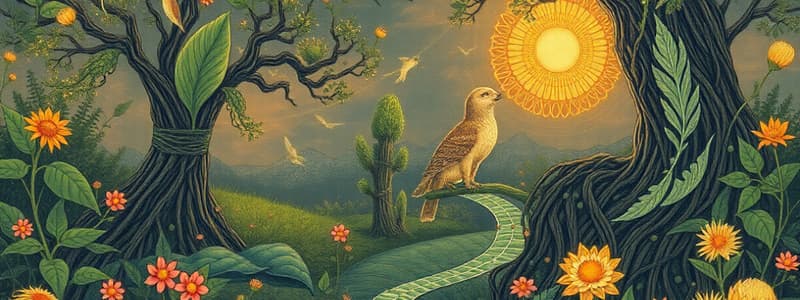Podcast
Questions and Answers
Which component of the biosphere represents life?
Which component of the biosphere represents life?
- Lithosphere
- Biosphere (correct)
- Atmosphere
- Hydrosphere
Photosynthesis converts glucose and oxygen into carbon dioxide and water.
Photosynthesis converts glucose and oxygen into carbon dioxide and water.
False (B)
What is the energy transfer percentage from one trophic level to the next?
What is the energy transfer percentage from one trophic level to the next?
10%
The formula for density is D = _____ / V.
The formula for density is D = _____ / V.
Match the scientific concept with its definition:
Match the scientific concept with its definition:
What happens during the red giant stage of a star's life cycle?
What happens during the red giant stage of a star's life cycle?
In a parallel circuit, the total resistance is always less than the resistance of the smallest resistor.
In a parallel circuit, the total resistance is always less than the resistance of the smallest resistor.
What is the primary purpose of the HR diagram in astronomy?
What is the primary purpose of the HR diagram in astronomy?
Flashcards
Photosynthesis
Photosynthesis
The process where plants use sunlight, carbon dioxide, and water to produce glucose (sugar) and oxygen.
Cellular Respiration
Cellular Respiration
The process where organisms break down glucose (sugar) in the presence of oxygen to release energy, carbon dioxide, and water.
Predation
Predation
A type of interaction where one organism benefits by consuming another organism.
Competition
Competition
Signup and view all the flashcards
Covalent Bonding
Covalent Bonding
Signup and view all the flashcards
Ionic Bonding
Ionic Bonding
Signup and view all the flashcards
Density
Density
Signup and view all the flashcards
Ohm's Law
Ohm's Law
Signup and view all the flashcards
Study Notes
Biology Study Notes
-
Biosphere Components: Earth's biosphere includes four interconnected spheres: lithosphere (land), hydrosphere (water), atmosphere (air), and biosphere (all living organisms).
-
Energy Flow: Ecosystems transfer energy. Photosynthesis converts carbon dioxide and water into glucose and oxygen. Cellular respiration reverses this, using glucose and oxygen to produce energy, carbon dioxide, and water. Only 10% of energy moves to the next trophic level.
-
Matter Cycling: The nitrogen cycle involves bacteria fixing nitrogen, plants absorbing it, and decomposition returning it to the atmosphere. The carbon cycle includes photosynthesis (absorbing CO2) and respiration/combustion (releasing CO2).
-
Ecological Interactions: Key interactions include predation (one organism hunting another), competition (organisms vying for resources), mutualism (both organisms benefit), commensalism (one benefits, the other is unaffected), and parasitism (one benefits, the other is harmed).
Chemistry Study Notes
-
Matter Classification: Matter is classified as pure substances (elements or compounds), which are one type of atom or molecule, or mixtures (solutions or mechanical mixtures), which contain two or more substances.
-
Periodic Table: The periodic table organizes elements. Groups (vertical columns) show similar properties, and periods (horizontal rows) indicate increasing energy levels.
-
Atomic Structure: Atoms contain protons (+), neutrons (neutral), and electrons (-). Atomic mass equals the sum of protons and neutrons.
-
Chemical Bonding: Ionic bonding occurs between a metal and non-metal through the transfer of electrons. Covalent bonding happens when non-metals share electrons.
Physics Study Notes
-
Ohm's Law: Voltage (V) equals current (I) times resistance (R): V = IR.
-
Circuits: Series circuits have the same current, and resistance adds up. Parallel circuits have the same voltage, and total current adds up.
-
Static Electricity: Objects can become charged through friction, contact, or induction.
Astronomy Study Notes
-
Earth-Moon System: The Earth-Moon system involves phases of the moon, eclipses, and tides.
-
Life Cycle of Stars: Stars develop from nebulae, go through main sequence stages, expand into red giants, and eventually collapse into white dwarfs or black holes.
-
HR Diagram: The Hertzsprung-Russell (HR) diagram plots stellar brightness against temperature to classify stars
Studying That Suits You
Use AI to generate personalized quizzes and flashcards to suit your learning preferences.




